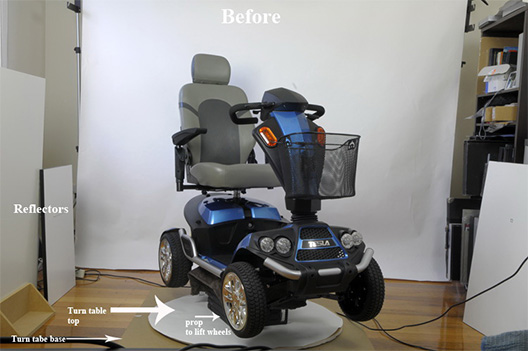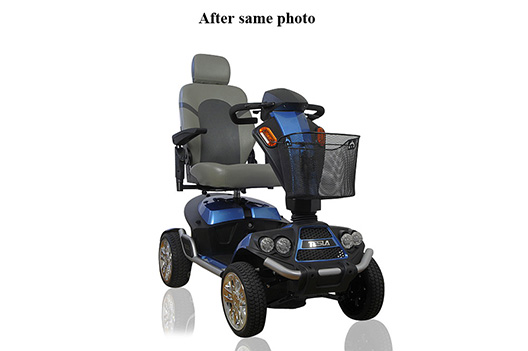In this guest blog post our friend, an Australian product photographer Bary Daly, is sharing his 360 photography setup that they used to capture 360 product images of several scooters for one of their clients.
I shot 4 mobile scooters last year for a company here in Melbourne. I did it here in my small studio which would be a 6 m x 4 m. The scooters are very heavy so it took 2 people to get them in then lift them up on the turntable.
I have a very unsophisticated set up. I used 3 direct light heads with five (28watt fluorescent colour temperature 5000k-5500k) bulbs in each head. These lights plus reflectors on both sides of the scooter and at the back was all the light needed.

I used direct lights because flash lights make the rotation flicker as there is a slight difference in power output between each flash. To keep the perspective of the scooter right I positioned the camera as far back as possible with a 105mm lens. The aperture also needs to be at least f16 to give sharp definition to the scooter from back to front. I focused on the front then set to manual so it would not change as the scooter spins. At f16 the shutter needs to be dragged to get the best exposure I’m not sure exactly what it was but the camera needs to be on a tripod.
The top part of the turntable is marked 24 evenly around. I did this by putting masking tape around the top of the turntable then peeling it off measuring it and dividing it by 24. 24 images works well for large items smaller products need more images per rotation to make them look smooth.

Once the 24 images are complete a clipping paths is done for each image to knock out the background and fill it with white. I’ve also added a reflection on the tires to enhance the perception of depth.
This set up works well for most large items. The turntable is home made using 2 pieces of scrap woods with a 12 inch Lazy Susan bearing in between. It can take quite a bit of weight also. Live models also works well with this setup.
See the completed 360 product view here: http://www.see360degrees.com.au/scooter1-net.html
Bary Daly is a manager and a photographer at See 360 Degrees in Melbourne, Australia. His company offers a unique service based on the wealth of experience in product photography to truly make your products stand out. Visit their website for more information and check out their blog for more 360 photography samples and resources.
Like blogging? PhotoGear 360 is looking for guest bloggers who would like to share 360 product photography tips and tricks on this blog. Just send us an email to support at photogear360 dot com.


